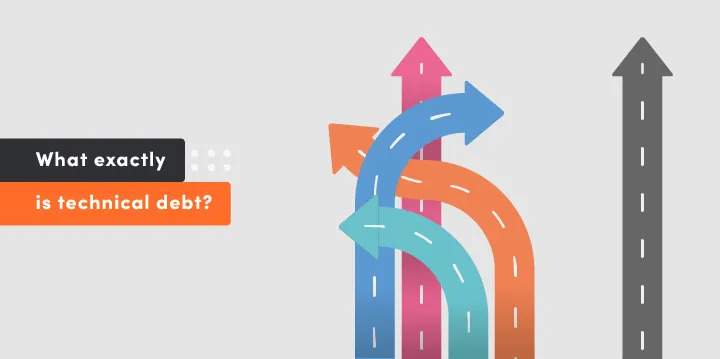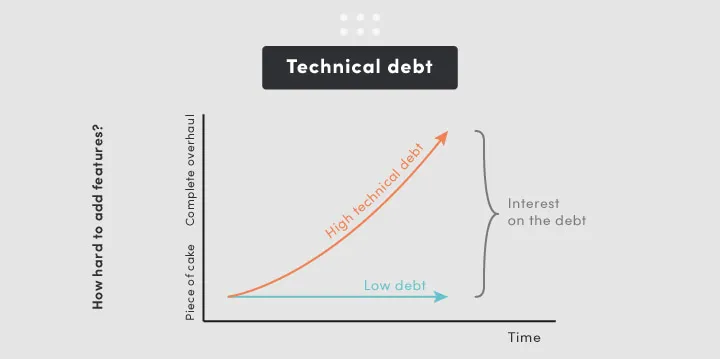If you have ever wondered what is technical debt in software development, this guide gives you a clear and practical view. It explains what tech debt is, where it appears in products, how it grows, and how a CTO can keep it under control.
-
Technical debt is extra work created by fast but imperfect decisions.
-
Different debt types slow teams in different ways.
-
Debt grows with pressure, weak process, and poor documentation.
-
Intentional debt can help; unintentional debt becomes harmful fast.
-
You measure debt with cycle time, defects, complexity, and delays.
-
The best fix is steady in-sprint refactoring supported by automation.
What Is Technical Debt in Software Development? From Metaphor to CTO Reality
Technical debt in software development is the extra work you will need to do later because you chose a faster, less ideal solution today. Technical debt refers to the future costs of rework created when a software development team chooses a faster, less optimal solution today. The term technical debt was first used by software developer Ward Cunningham, and the idea is described in detail on Wikipedia. People often shorten the phrase and say tech debt. When you hear this term, think about every shortcut in your development process that you will have to revisit in the future. A classic example of technical debt is the Year 2000 (Y2K) problem, where software developers stored dates as two digits to save memory, leading to massive cleanup efforts as the year 2000 approached.
The idea comes from a simple financial debt metaphor. In money, you have the main amount, the interest, and the final repayment. In software engineering, the “principal” is the quick code you write now to unlock speed. The “interest” shows up later as bug fixes, refactors, and extra work in each development cycle. What actually constitutes technical debt can be bad code, missing tests, a rigid design, or a lack of documentation that slows future development. Over time these choices add friction to the way the team writes code and ships changes.

At some point this metaphor stops being only a nice story, especially for a CTO. A leader has to look at technical debt as clear numbers and risks, not only as a story about messy code. The real problem is when these future costs start to hurt delivery, increase outages, or create long term consequences for the business. Excessive technical debt can slow innovation, preventing businesses from responding quickly to customer demands and leading to customer churn. You can see this when simple features take longer every quarter or when maintenance work eats a growing part of each sprint. In that moment technical debt becomes a direct threat to long term sustainability, not only to the codebase itself.
The key point is that technical debt is natural in almost every software project. Teams make trade offs all the time to hit dates or test ideas. The goal for a CTO is not to remove all tech debt, but to keep its “interest” under control. Sometimes taking on debt is a smart move if it supports a clear product bet and a plan to clean up later. What matters is that the team can explain where the debt sits, how big the future costs may be, and how it affects both technical work and the rest of the company.
Common Types of Technical Debt: From Code Debt to Architectural Debt
Common types of technical debt sit in the code, in the design, in the tests, and in the way the team works. The main technical debt types are code debt, design debt, architecture debt, test debt, documentation debt, infrastructure debt, process debt, service debt, and defect debt. Each type hurts the team in a slightly different way. Some slow down developers. Some create more bugs. Some make every change feel risky instead of calm and predictable.
Code debt is about the code itself. It shows up as messy code, redundant code, and no clear style. It makes it hard to work with existing code because every change takes longer than it should. Code debt slowly damages long term code quality and turns simple tasks into heavy maintenance work.

Architecture debt, also called architectural debt, is about the structure of the system. It appears when modules are too tightly connected, do not scale, or are hard to integrate with legacy systems. This type is very visible in larger products built through custom software development. Architecture debt limits the future growth of the product even if the surface code still looks fine.
There are also test debt, documentation debt, infrastructure debt, process debt, service debt, and defect debt. Test debt appears when there are too few tests or tests are hard to run. Documentation debt appears when guides are missing or out of date. Security debt arises when teams cut corners on encryption, authentication, or vulnerability patching, leaving software exposed to cyberthreats. These types of technical debt emerge over time and lead to real maintenance challenges for software development teams and engineering teams. They do not always make noise at once but they lower software quality day after day.
Design Debt, Documentation Debt, and Infrastructure Debt in Growing Products
Design debt, documentation debt, and infrastructure debt slow growing products in quiet but very real ways. Design debt, documentation debt, and infrastructure debt silently slow down growing products by making every new change harder to plan, build, and deploy. Design debt appears when screens, flows, and components do not follow one clear design system. Each new feature then needs extra design work and extra fixes, which leads to more maintenance challenges.
Documentation debt appears when guides, diagrams, and notes are missing or out of date. New people join and need to ask basic questions for every task. Documentation debt turns onboarding into a long and painful process and keeps knowledge locked in a few minds. This also hurts process debt, because the team cannot agree on one clear way of work, and people lose time in chats and meetings that should not be needed. Developers often create documentation debt when they are too rushed to document their code thoroughly, leading to a lack of understanding for future developers.

Infrastructure debt shows up in build and release steps that are manual, fragile, or slow. This is very visible in products that use many programming languages or many small services. Infrastructure debt makes simple deploys risky and slows the team even if the code for a feature is ready. Teams often track this type of work as infra or ops tickets inside project management tools, but if these tickets stay in the backlog for too long, they grow into a real wall for future changes.
Defect Debt and Code Quality: When Bugs Become Technical Debt
Not every bug is technical debt, but some groups of bugs clearly are. Defect debt is the backlog of known but unfixed bugs that permanently drags down code quality and slows every future change. These bugs sit in bug tracking systems and stay there sprint after sprint. Over time they lower overall software quality and make developers worry each time they touch the same areas.
Defect debt grows faster when there is poor code quality and weak testing. When a team has large test debt and little automated testing, each fix feels risky. Without solid continuous integration and good test automation frameworks on reliable CI servers, every bug fix can create new bugs and new regressions. This is how test automation debt appears and pushes the team into a loop of fixing the same problems again and again.
A large backlog of bugs also changes how users see the product. People meet the same errors and lose trust, and some decide to stop using the product at all. A simple rule is to reserve part of each sprint for defect debt so that bug fixes move forward, not only new features. This steady work keeps defect debt at a safer level and protects software quality and the long term roadmap.
Try our developers.
Free for 2 weeks.
No risk. Just results. Get a feel for our process, speed, and quality — work with our developers for a trial sprint and see why global companies choose Selleo.
Causes of Technical Debt in Modern Development Teams
Technical debt accumulates when teams trade long-term health for short-term speed. Technical debt accumulates when tight deadlines, incomplete requirements, poor management, missing skills, and weak practices push teams to ship fast and clean up later. This pattern appears in many development teams, even those with strong talent and good tooling. Over time these choices stretch the development cycle and make every change slower and more stressful.
One clear group of causes comes from project and product pressure. Tight deadlines, heavy business pressure, and a constant push for new features shape most roadmaps. Product owners respond to customer feedback and often request fast changes without room for refactoring. In these conditions technical debt emerges even inside mature agile development teams that try to follow good practice. This is visible in many examples found in the Case Study Selleo materials, where clients arrived with debt created under intense time pressure.
Another group of causes sits in process and documentation issues. Many software development teams work with missing documentation or very poor documentation. People ask the same questions again, and important decisions sit only in chat history. Poor management and poor project management leave no time for stable process, which leads to increased complexity and slow decision-making. This then turns into increased maintenance costs because every change requires someone to rebuild old context.

There is also a quiet but strong source of debt in skills and tools. Some engineering teams lack experience in system design, testing, or automation of releases. They have no stable way to protect software quality during each development time window. When teams build complex systems without solid skills and tools, technical debt emerges as a natural side effect of normal work. Over time this creates solutions that are hard to understand, hard to change, and more expensive to maintain.
Intentional Technical Debt vs Accidental and Unavoidable Debt
Intentional technical debt is a planned choice that supports a clear goal, while unintentional technical debt appears by accident. Intentional technical debt can be a strategic tool when it is documented and planned for repayment, while unintentional technical debt is a symptom of poor practices and quickly becomes excessive technical debt. Teams often take intentional debt to hit a release date or support a product roadmap event. This form of debt works only when it is visible and tracked.
Unintentional technical debt appears when the team lacks skills or stable review habits. People move fast, skip checks, or do not know a better approach. Unintentional technical debt grows faster because it hides inside the codebase without a clear owner or plan. It also forms when teams work without shared rules or when poor documentation blocks good decisions. Over time this type turns into technical debt bad because it creates a cycle of slow and risky changes.
Some debt is unavoidable and appears even in strong teams. Markets change, frameworks evolve, and tools reach end of life. Unavoidable debt becomes harmful only when the team ignores it and lets it pile up without a clear debt log or repayment date. A simple debt register with short notes and expected repayment windows helps keep this work visible. With this view a team can prevent old choices from turning into excessive technical debt.
Examples of Technical Debt in SaaS, EdTech, and HRTech Products
Classic examples of technical debt show up in old systems and in brand new products. Classic examples of technical debt include legacy code that nobody wants to touch, outdated third-party libraries, hard-coded business rules, and brittle integrations that block new features. The Y2K problem is a famous case where dates were stored with two digits to save memory and later caused huge cleanup work. The launch of HealthCare.gov in 2013 faced significant issues due to compressed timelines, resulting in system crashes and security vulnerabilities.
In SaaS platforms, technical debt often hides in existing code that grew fast with little planning. Teams rush and leave bad code, redundant code, and one-off feature flags in place. These shortcuts turn into service debt and infrastructure debt that make every change harder and slower. This pattern is common in teams that scale complex products through SaaS development services, where growth comes first and clean-up comes later.
In EdTech and HRTech, many products run on LMS platforms that carry years of history. Teams still rely on legacy systems with old reporting modules and no modern API support. This creates design debt and documentation debt, plus long term consequences such as manual exports and slow data access. You can see these maintenance challenges in many E-learning software development projects and in large organisations that depend on a custom LMS for enterprise that was never fully modernised.

In FinTech apps, environmental technical debt appears when banks change their APIs or rules. Old payment flows keep using outdated libraries and fragile integrations. This underlying technical debt can lead to outages, failed payments, and extra checks for every release. Similar patterns appear in custom FinTech software development and in public sector platforms such as the one described in Case Study Exegov, where legacy code and brittle services slowed new features.
Typical examples of technical debt in these domains
- Legacy code in core billing or enrolment flows that no one wants to refactor.
- Outdated third-party libraries that block upgrades and create security risk.
- Hard-coded pricing, roles, or access rules that make simple changes very costly.
- Brittle integrations between services that break whenever a provider changes an API.
- Missing or outdated documentation that turns small fixes into long investigations.
How CTOs Can Use Code Reviews and Architecture Governance to Stay in Control
Code reviews and simple architecture rules are the daily tools a CTO can use to manage technical debt. Disciplined code reviews and lightweight architecture governance are the cheapest ways for CTOs to manage technical debt before it becomes a crisis. When these habits are part of normal work, bad patterns are caught early. This helps software development teams avoid hidden issues that later explode into big maintenance challenges.
Good code reviews are not about catching typos. They are about long term code quality. A clear review checklist for tests, readability, performance, and security helps prevent technical debt at the pull request stage. A few focused hours per week on reviews cost less than weeks of debugging broken features. Code reviews also share knowledge across engineering teams, so fewer people ship risky changes by mistake.
Architecture governance sounds heavy, but it can stay very light. Simple rules like clear service boundaries, standard ways to call APIs, and one place for shared logic already help a lot. A small architecture guild that records decisions in a short log can prevent technical debt in fast moving teams. This approach works well in complex custom mobile App development projects, where many platforms share one core and need stable integration rules.
Automation ties it all together. Continuous integration with static checks and tests makes sure that rules are followed on every commit. When CI pipelines, code reviews, and a simple debt register live inside project management tools, addressing technical debt becomes part of normal risk management. Automated testing practices ensure comprehensive test coverage and help identify defects early. CTOs can then see where debt grows, link it to specific parts of the system, and plan work before it hurts delivery.
Identifying and Measuring Technical Debt: Metrics and Signals for CTOs
You measure technical debt by watching how your team moves and where it slows down. You measure technical debt by tracking metrics like cycle time, defect rate, MTTR, complexity, missing test coverage, and how often legacy code blocks new work. A vague “we feel there is debt” does not help with the board or with planning. Clear numbers make future costs visible and turn a fuzzy topic into a real risk line. This is the base for any talk about long term sustainability.
A first group of signals lives in day-to-day delivery. Look at cycle time for changes in areas with heavy existing code, and compare it to cleaner parts of the system. Track defect rate and how many regressions appear in each release. If a growing share of each sprint goes into fixing legacy code, it is a clear sign that technical debt accumulates and drives increased maintenance costs. Tools and reports around fixing legacy code from sources like fixing legacy code can help you name these patterns in a simple way.
Here are common early warning signals that appear before debt becomes a crisis:
- Cycle time grows week by week, even for small tasks.
- More bugs appear in old modules than in new ones.
- Engineers avoid parts of the system because changes always “break something”.
- Test coverage in critical flows stays low for months.
- Reviews take longer because increased complexity slows everyone down.
A second group of signals lives in structure and complexity. Notice how often a “small change” needs edits in five or six modules. Count how often engineers report that increased complexity in old areas blocks future development. When simple features need many code changes, you see the long term consequences of hidden debt in your architecture. Static analysis tools, such as SonarQube and similar scanners, can give simple scores that show hot spots in existing code. Even a basic view of complex files, deep nesting, and missing tests can show where future costs will grow. Efforts to manage technical debt also include automating testing and deployment processes, which help reduce risks and improve efficiency.
A third group of signals is visible to the business. Watch how many releases slip, how many deals you lose because a feature is “not possible right now”, and how often SLAs are close to a miss. When technical debt results in slower delivery and lost deals, it turns from a code problem into a clear business risk. You can map this to money with a simple question: “If this delay stops one enterprise deal per quarter, what is the monthly cost?” That makes increased complexity and long term consequences very real for non-technical leaders.
Technical Debt Reduction Strategies That Don’t Kill Feature Delivery
Reducing technical debt works best when it becomes a steady habit, not a separate project. The most effective way to reduce technical debt without killing delivery is to reserve 10–20% of sprint capacity for refactoring and debt reduction, prioritised by business impact rather than code smell. This keeps development teams focused on both new features and long term stability. A clear rule also prevents debt from growing in hidden areas. You can explore a deeper playbook in resources like how to reduce technical debt.
A practical method is incremental refactoring inside normal work. Teams improve small pieces of legacy code each time they touch them. This reduces maintenance challenges without stopping the roadmap. Small changes protect delivery because they avoid the long freeze that comes with big cleanups. Simple habits like improving names, adding missing tests, or removing redundant code all add up. Automated testing and continuous integration help prevent test debt and let teams move faster with less risk.
Here is a comparison of two common approaches to debt reduction:
Infrastructure debt, documentation debt, and process debt also need dedicated time. These areas slow work even when code is clean. Simplifying pipelines, removing old scripts, and updating shared docs often bring faster wins than touching the code itself. Better docs reduce onboarding time, and clearer processes help teams avoid creating new debt. All of these support long term sustainability in future development.
A steady reduction plan is easier to explain to business leaders when results appear early. Track bug fixes, cycle time, and the share of work spent inside legacy code modules. When these numbers improve after two or three iterations, it shows that addressing technical debt increases delivery speed rather than slowing it. This helps the roadmap stay on track while the system becomes safer and easier to extend. Clear data turns invisible debt into a visible business gain.
A Technical Debt Playbook for Startup and Scaleup CTOs
A simple technical debt playbook gives a startup or scaleup CTO clear next steps, not just theory. A practical technical debt playbook for CTOs combines clear definitions, visible tracking, disciplined engineering practices, and regular investment in debt reduction aligned with business goals. It treats technical debt as part of risk management, not as an afterthought. It also makes the real technical debt results visible to people outside engineering. That is the core conclusion technical debt points to in fast-growing teams.
A good playbook is short and easy to share. You name the main debt areas, measure them, and link them to the roadmap. You protect software quality inside normal agile development. These simple moves protect long term code quality while the product still moves fast. They also work across many programming languages and tech stacks. They fit products in SaaS, EdTech, HRTech, FinTech, and service platforms.
You can turn this into a quick weekly checklist with your leads:
- Do we know our top three debt areas that hurt delivery today?
- Do we track how much time we spend in legacy code and service debt each sprint?
- Do we see clear owners for tests, architecture, and documentation, or do we rely on hero work?
- Do we review poor documentation and missing docs during retros, not only features?
- Do customer feedback and roadmap talks include space for debt work, not only new features
These questions make technical debt concrete and show where poor management and poor documentation slow the team.
If you ignore this playbook, the effects build up slowly and then all at once. Technical debt bad enough can block releases and push strong people to leave. Unchecked debt turns into higher maintenance challenges and lower software quality, which hurts long term sustainability. It also makes risk management harder, because failures seem random. A simple, written playbook keeps everyone aligned on what to fix first and why it matters for the business, not only for the code.
You see it when small tasks take longer, regression bugs grow, and engineers avoid certain modules. These signals show that debt is blocking real work, not just code cleanup.
Most teams stay healthy by reserving 10–20% of each sprint for refactoring, bug fixes, and test work. This keeps delivery stable while reducing long-term risk.
Start with debt that slows the roadmap or creates outages. Focus on legacy code hotspots, brittle integrations, and low-test areas that cause repeated regressions.
Translate it into missed deadlines, slower releases, higher support costs, and blocked deals. Debt is easier to prioritise when its business impact is visible and concrete.
Use clear review rules, simple architecture standards, and automated tests. These habits catch weak changes early and protect the team from repeating the same mistakes.





